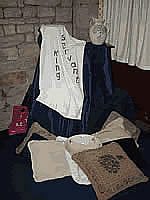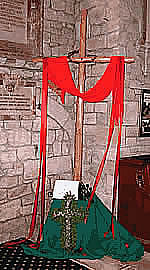 St Mary's Church, Dymock
St Mary's Church, Dymock
| Admin | |||
| . | Home | Contents | |
| H&S Policy | People Safety | Grave Yard | |
The Church & The World
Faith & Care
Faith & Care
Things Past
People & Features
People & Features
Easter Explained
Easter is the principal festival of the Christian Church - but what's it all about? The Bible tells us how Jesus' time on earth came to an end. He was betrayed by one of his followers, Judas Iscariot, falsely accused, handed over to the authorities for a mock trial, tortured, and finally executed on a wooden cross as a common criminal. He had planned it all - in his death on the cross he took on himself all the wrongs any of us have ever done, or ever will do, and so made reconciliation with God for our disobedience - which we call 'sin'.
In his great love for us, God gave us free will to chose what we want to do, but he intended that we would show caring love towards him and each other so he gave us rules to guide us (The Ten Commandments - Exodus 20:1-17). Although they're really quite simple - we humans find it difficult to keep those rules and are always breaking them, which separates us from God, much like a naughty child is separated from its human parents. No human has ever been good enough to put right that separation, so God came himself in the human form of Jesus to do it for us; and it's as a result of what Jesus did for us on the cross that we're reconciled back to God and can have eternal life with him after we die, as he always intended - and that's a festival worth celebrating.
To help us understand it, the events of the Easter account were illustrated in 6 displays placed around Dymock Church.
In his great love for us, God gave us free will to chose what we want to do, but he intended that we would show caring love towards him and each other so he gave us rules to guide us (The Ten Commandments - Exodus 20:1-17). Although they're really quite simple - we humans find it difficult to keep those rules and are always breaking them, which separates us from God, much like a naughty child is separated from its human parents. No human has ever been good enough to put right that separation, so God came himself in the human form of Jesus to do it for us; and it's as a result of what Jesus did for us on the cross that we're reconciled back to God and can have eternal life with him after we die, as he always intended - and that's a festival worth celebrating.
To help us understand it, the events of the Easter account were illustrated in 6 displays placed around Dymock Church.

When Jesus came into Jerusalem, the crowd was excited and restless. Many had heard of Jesus' teaching about God and about the miracles he was doing, so they thought he was the long-promised Messiah. As Jesus rode into the city on a young donkey the people cheered and praised God shouting, 'Blessed is the king who comes in the name of the Lord.'
People began to throw their cloaks on the ground to pave his way, and to wave palm leaves torn from the trees, which was what they did for people of great worth. Their hearts were full of expectation.
But the religious leaders grumbled about Jesus, because they didn't think he was the Messiah and were afraid he was undermining their authority. But Jesus told them, 'I tell you that if the people keep quiet, the stones themselves will shout out' (Luke 19:40).
* 'Messiah' is the Hebrew word used in the Old Testament and is translated into Greek in the New Testament as 'Christ', both words mean the same - 'chosen' or 'anointed one' . Christians understand it means Jesus was chosen by God to make reconciliation with him for our sins.
(Return to Top)

Israel is a hot, dry land and in those days most people travelled on foot, so it was the custom to welcome visitors by washing their dusty feet. Normally a household servant did this - the lowest of the low. When Jesus invited his disciples to supper in the upper room, they were surprised by what Jesus did.
He rose from the table, took off his outer garment, and tied a towel around his waist. Then he poured some water into a basin and began to wash their feet, drying them with the towel round his waist. When he had finished, he returned to his place and asked, "Do you understand what I have done for you? You call me teacher and Lord, and rightly so, for that is what I am. Now that I, your Lord and teacher, have washed your feet, you also should wash one another's feet. I have set you an example, that you should do as I have done for you." He added, "Now I give you a New Commandment: love one another. As I have loved you, so you must love one another." (John 13:4-5, 12-15 & 34).

(*Eucharist is a Greek word that means 'Thanksgiving' and refers to the Great Prayer of Thanksgiving when the priest gives thanks to God and blesses the bread and wine during the Service of Holy Communion).

He went a little further on, threw himself face downwards on the ground, and prayed, 'My Father, if it is possible, take this cup of suffering from me. Yet not what I want, but what you want.' Then he returned to the three disciples and found them asleep. He said to Peter, 'How is it that you three were not able to keep watch with me even for one hour?
He went away and prayed for a second and third time, each time returning and finding them asleep again. The last time he said, 'Get up, let us go. Look, here is the man who is betraying me.' (Matthew 26:36-40 & 46).
(Return to top)

They came to a place called Golgotha, which means 'The place of the skull'. There.... they crucified him and then divided his clothes among them by throwing dice.... Above his head they put a written notice of the accusation against him: "This is Jesus of Nazareth, the King of the Jews." At 3 pm, Jesus died. (Matthew 27:27-37).
At that moment, the curtain hanging in the Temple to separate the 'Holy of Holies' from the people was torn apart. The Holy of Holies was where they thought God dwelt. No one was allowed there except the high priest, and he only once a year after great formality. The curtain was torn because Jesus had restored our relationship with God, so we are no longer separated from him.
It was so close to the start of the Sabbath, when in Jewish culture no work can be done, so the body couldn't be properly prepared for burial, so they took down the body of Jesus from the cross and placed it in a nearby tomb hewn from solid rock, and rolled a heavy stone across the entrance. Pilate had Roman guards placed at the entrance to ensure no-one interfered with it
* 'Angelos' is just the Greek word for 'Messenger' - so angels are messengers from God. (Human messengers are called prophets)

After the Sabbath, as Sunday morning was dawning, Mary Magdalen and the other Mary went to look at the tomb. Suddenly there was a violent earthquake; an angel of the Lord came down from heaven, rolled the stone away, and sat on it. His appearance was like lightning, and his clothes were white as snow. The guards were so afraid that they trembled and became like dead men.
The angel spoke to the women. 'You must not be afraid,' he said. 'I know you are looking for Jesus, who was crucified. He is not here; he has been raised, just as he said he would. Come here and see the place where he was lying. Go quickly now, and tell his disciples, He has been raised from death, and now he is going to Galilee ahead of you; there you will see him.' Remember what I have told you. (Matthew 28:1-7).
* 'Angelos' is just the Greek word for 'Messenger' - so angels are messengers from God. (Human messengers are called prophets)